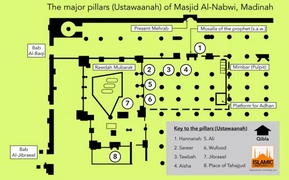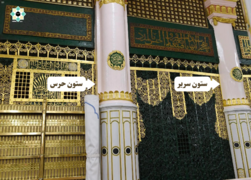Al-Haras Pillar
 | |
| General Information | |
|---|---|
| Other Names | Ali's pillar, al-Mahras pillar, Majlis al-Qallada pillar |
| Place | Medina, al-Masjid al-Nabawi |
| History | |
| Events | Ali (a) used to sit next to this pillar and guard the Prophet Muhammad (s). |
| Current State | |
| Status | This pillar is located behind the Pillar of Repentance, on the north, and opposite the Prophet's house, which is now his holy shrine. The Prophet (s) would enter the mosque through the door in front of the pillar to perform his prayers |
Al-Ḥaras pillar or al-Maḥras pillar(Arabic: الحَرَس or المَحرَس) is a pillar in al-Masjid al-Nabawi that Imam Ali(a) stood next to it to guard and protect Prophet Muhammad(a). This pillar is also known as Imam Ali's musalla (place of prayer) and the pillar of Ali is another name for this pillar. Al-Haras pillar is one of the pillars of the Prophet's holy shrine and half of it is inside the shrine.
Location
This pillar is located on the north side, behind the pillar of al-Tawba (repentance) and in front of the Prophet's house, which is now his holy shrine, and the prophet for praying used to enter the mosque through the door in front of it.[1] Now half of this pillar is located next to the prophet's holy shrine and inside the shrine.[2]
Reason for Naming
This pillar became famous because Imam Ali(a) used to stand next to it to guard the Prophet.[3]
Other names
Al-Mahras pillar
This pillar is also known as al-Mahras[4] the arabic word al-mahras (المحرس) is rooted from «ح ـ ر ـ س» that means, to guard and to protect.[5]
Ali's pillar
This pillar is also known as "Musalla Ali b. Abi Talib" because Imam Ali(a) recites his prayers next to it.[6]Based on the report of Samhoudi, the ruler of Medina used to pray near this pillar, in such a way that the pillar was placed behind him.[7]
Majlis Qallada pillar
This pillar was also called "Majlis Qallada"; Because the prominent companions surround it and hold it in the middle like a necklace.[8] Al-Samhudi did not accept this and considered Majlis Qallada to be another name for the pillar of wufud.[9]
Gallery
-
The map of Masjid al-Nabi where number 5 shows the location of the Ali's pillar.
-
Al-Haras pillar next to al-Sarir pillar.
Notes
- ↑ Maṭarī, Al-Taʿrīf bi-mā anasat al-hijra, p. 92.
- ↑ Shurrāb, al-Maʿālim al-athīra, p. 40.
- ↑ Maṭarī, Al-Taʿrīf bi-mā anasat al-hijra, p. 92; Samhūdī, Wafāʾ al-wafāʾ, vol. 2, p. 185.
- ↑ Maṭarī, Al-Taʿrīf bi-mā anasat, p. 92.
- ↑ Ibn Manẓūr, Lisān al-ʿArab, vol. 6, p. 48; word: «حرس».
- ↑ Ibn Zabāla, Akhbār al-madīna, p. 100; Shurrāb, Al-Maʿālim al-athīra, p. 40; Samhūdī, Wafāʾ al-wafā, vol. 2, p. 185.
- ↑ Samhūdī, Wafāʾ al-wafā, vol. 2, p. 185.
- ↑ Shurrāb, Al-Maʿālim al-athīra, p. 43.
- ↑ Samhūdī, Wafāʾ al-wafāʾ, vol. 2, p. 185.
References
- Ibn Manẓūr, Muḥammad b. Mukarram. Lisān al-ʿArab. Qom: Adab al-Ḥawza, 1405 AH.
- Ibn Zabāla. Akhbār al-madīna. Medina: Markaz Buḥūth wa Dirāsāt al-Madina al-Munawwara, 1424 AH.
- Maṭarī, Muḥammad b. Aḥmad al-. Al-Taʿrīf bi-mā anasat al-hijra min maʿālim dār al-hijra. Riyadh: Dār al-malik ʿAbd al-ʿAzīz, 2005.
- Samhūdī, ʿAlī b. ʿAbd Allāh al-. Wafāʾ al-wafāʾ bi-akhbār dar al-Muṣṭafā. Edited by Muḥammad Muḥyi l-Dīn ʿAbd al-Ḥamīd. Beirut: 1984.
- Shurrāb, Muḥammad b. Muḥammad Ḥasan. Al-Maʿālim al-athīra. Tehran: Mashʿar, 1383 sh.
- Yamānī, Aḥmad Zakī al-. Mawsūʿat Makka al-mukarrama wa l-Madina al-munawwara. London: Muʾssisa al-Furqān, 1429 AH.

